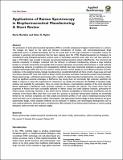| dc.contributor.author | Buckley, Kevin | |
| dc.contributor.author | Ryder, Alan G. | |
| dc.date.accessioned | 2018-02-28T14:08:24Z | |
| dc.date.available | 2018-02-28T14:08:24Z | |
| dc.date.issued | 2017-05-23 | |
| dc.identifier.citation | Buckley, Kevin, & Ryder, Alan G. (2017). Applications of Raman Spectroscopy in Biopharmaceutical Manufacturing: A Short Review. Applied Spectroscopy, 71(6), 1085-1116. doi: 10.1177/0003702817703270 | en_IE |
| dc.identifier.issn | 1943-3530 | |
| dc.identifier.uri | http://hdl.handle.net/10379/7177 | |
| dc.description.abstract | The production of active pharmaceutical ingredients (APIs) is currently undergoing its biggest transformation in a century.
The changes are based on the rapid and dramatic introduction of protein- and macromolecule-based drugs
(collectively known as biopharmaceuticals) and can be traced back to the huge investment in biomedical science (in
particular in genomics and proteomics) that has been ongoing since the 1970s. Biopharmaceuticals (or biologics) are
manufactured using biological-expression systems (such as mammalian, bacterial, insect cells, etc.) and have spawned a
large (>E35 billion sales annually in Europe) and growing biopharmaceutical industry (BioPharma). The structural and
chemical complexity of biologics, combined with the intricacy of cell-based manufacturing, imposes a huge analytical
burden to correctly characterize and quantify both processes (upstream) and products (downstream). In small molecule
manufacturing, advances in analytical and computational methods have been extensively exploited to generate process
analytical technologies (PAT) that are now used for routine process control, leading to more efficient processes and safer
medicines. In the analytical domain, biologic manufacturing is considerably behind and there is both a huge scope and need
to produce relevant PAT tools with which to better control processes, and better characterize product macromolecules.
Raman spectroscopy, a vibrational spectroscopy with a number of useful properties (nondestructive, non-contact, robustness)
has significant potential advantages in BioPharma. Key among them are intrinsically high molecular specificity, the
ability to measure in water, the requirement for minimal (or no) sample pre-treatment, the flexibility of sampling configurations,
and suitability for automation. Here, we review and discuss a representative selection of the more important
Raman applications in BioPharma (with particular emphasis on mammalian cell culture). The review shows that the
properties of Raman have been successfully exploited to deliver unique and useful analytical solutions, particularly for
online process monitoring. However, it also shows that its inherent susceptibility to fluorescence interference and the
weakness of the Raman effect mean that it can never be a panacea. In particular, Raman-based methods are intrinsically
limited by the chemical complexity and wide analyte-concentration-profiles of cell culture media/bioprocessing broths
which limit their use for quantitative analysis. Nevertheless, with appropriate foreknowledge of these limitations and good
experimental design, robust analytical methods can be produced. In addition, new technological developments such as
time-resolved detectors, advanced lasers, and plasmonics offer potential of new Raman-based methods to resolve existing
limitations and/or provide new analytical insights. | en_IE |
| dc.description.sponsorship | KB is a Government of Ireland Postdoctoral Fellow and would like to thank the Irish Research Council for their support (Grant no.: GOIPD/2015/88). Some support for KB from the Synthesis and Solid State Pharmaceutical Centre, funded by Science Foundation Ireland and industry partners (Grant no.: 12/RC/2275) is also acknowledged. | en_IE |
| dc.format | application/pdf | en_IE |
| dc.language.iso | en | en_IE |
| dc.publisher | Sage Publications | en_IE |
| dc.relation.ispartof | Applied Spectroscopy | en |
| dc.rights | Attribution-NonCommercial-NoDerivs 3.0 Ireland | |
| dc.rights.uri | https://creativecommons.org/licenses/by-nc-nd/3.0/ie/ | |
| dc.subject | Raman spectroscopy | en_IE |
| dc.subject | Biopharmaceutical manufacturing | en_IE |
| dc.subject | Cell culture media | en_IE |
| dc.subject | Chemometrics | en_IE |
| dc.subject | Online monitoring | en_IE |
| dc.subject | Proteins | en_IE |
| dc.title | Applications of raman spectroscopy in biopharmaceutical manufacturing: A short review | en_IE |
| dc.type | Article | en_IE |
| dc.date.updated | 2017-05-26T15:08:01Z | |
| dc.identifier.doi | 10.1177/0003702817703270 | |
| dc.local.publishedsource | https://doi.org/10.1177/0003702817703270 | en_IE |
| dc.description.peer-reviewed | peer-reviewed | |
| dc.contributor.funder | Irish Research Council | en_IE |
| dc.contributor.funder | Science Foundation Ireland | en_IE |
| dc.internal.rssid | 12650405 | |
| dc.local.contact | Alan Ryder, School Of Chemistry, Room 213, Arts/Science Building, Nui Galway. 2943 Email: alan.ryder@nuigalway.ie | |
| dc.local.copyrightchecked | No Article is Open access on the Applied Spectroscopy website. | |
| dc.local.version | PUBLISHED | |
| dcterms.project | info:eu-repo/grantAgreement/SFI/NSF/SFI Graduate Research Opportunities Worldwide (GROW) Programme/12/RC/2275s3/IE/Synthesis and Solid State Pharmaceutical Centre (SSPC) GROW Supplement/ | |
| nui.item.downloads | 1151 | |


